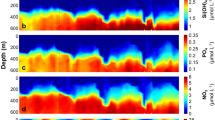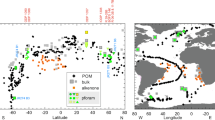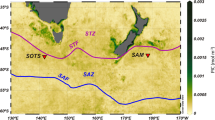Abstract
A model1,2, which explains the vertical and seasonal distribution of planktonic foraminifera was developed using data from the western North Atlantic and is comprised of three tenets: (1) The conditions in the photic zone (upper 80–100 m) exclusively dictate planktonic foraminifera species composition and abundance throughout the water column. (2) Species are vertically stratified within the photic zone according to their temperature preference. Depth distribution according to temperature preference has been proposed by several authors3 based on isotope analyses of sediments. Due to seasonal temperature variations, seasonal variations in the δ18O composition of seawater, and species-specific isotope fractionation, rigorous proof of this hypothesis cannot be provided from sediment analyses alone. (3) The chlorophyll maximum is a major food source zone, which is preferentially exploited by foraminifera. Our data from the Panama Basin, which are presented here, are confirmation of this model. The Panama Basin in the eastern equatorial Pacific, which has a shallow and steep thermocline, was sampled for living planktonic foraminifera. A multiple opening–closing net and environmental sensing system (MOCNESS)4 was used to collect 13 sets of eight vertically stratified oblique samples. We report here the quantitative distribution and stable isotopic composition of planktonic foraminifera from four MOCNESS tows taken over 5 days, during August 1979 (RV Knorr cruise 73) at 5°20′ N, 8°50′ W. Each tow consisted of eight samples which integrated ∼12.5-m intervals from 0 to 100 m for MOC 126, 25-m intervals from 0 to 200 m for MOC 127, 100–150-m intervals from 0 to 1,000 m on MOC 128 and 250-m intervals from 0 to 2,000 m on MOC 131.
This is a preview of subscription content, access via your institution
Access options
Subscribe to this journal
Receive 51 print issues and online access
$199.00 per year
only $3.90 per issue
Buy this article
- Purchase on Springer Link
- Instant access to full article PDF
Prices may be subject to local taxes which are calculated during checkout
Similar content being viewed by others
References
Fairbanks, R. G. & Wiebe, P. H. Science 209, 1524 (1980).
Fairbanks, R. G., Wiebe, P. H. & Bé, A. W. Science 207, 61 (1980).
Emiliani, C. Am. J. Sci. 252, 149 (1954).
Wiebe, P. H., Burt, K. H., Boyd, S. H. & Morton, A. W. J. mar. Res. 34, 313 (1976).
Fairbanks, R. G. J. geophys. Res. 87, 5796 (1982).
Broecker, W. S. Prog. Oceanog. 11, 151 (1982).
Marra, J., Wiebe, P. H., Stepien, J. C. & Bishop, J. K. (in preparation).
Epstein, S., Bucksbaum, R., Lowenstam, H. A. & Urey, H. C. Bull. geol. Soc. Am. 64, 1315 (1953).
Williams, D. F., Bé, A. W. H. & Fairbanks, R. G. Science 206, 447 (1979).
Turner, J. V. (in preparation).
Author information
Authors and Affiliations
Rights and permissions
About this article
Cite this article
Fairbanks, R., Sverdlove, M., Free, R. et al. Vertical distribution and isotopic fractionation of living planktonic foraminifera from the Panama Basin. Nature 298, 841–844 (1982). https://doi.org/10.1038/298841a0
Received:
Accepted:
Issue Date:
DOI: https://doi.org/10.1038/298841a0
This article is cited by
-
Intrusion of Arabian Sea high salinity water and monsoon-associated processes modulate planktic foraminiferal abundance and carbon burial in the southwestern Bay of Bengal
Environmental Science and Pollution Research (2024)
-
Intermediate water circulation drives distribution of Pliocene Oxygen Minimum Zones
Nature Communications (2023)
-
The FORCIS database: A global census of planktonic Foraminifera from ocean waters
Scientific Data (2023)
-
Deglacial restructuring of the Eastern equatorial Pacific oxygen minimum zone
Communications Earth & Environment (2022)
-
Distribution and environmental implications of planktonic foraminifera in the surface sediments of southwestern part of Bay of Bengal, India
Journal of Sedimentary Environments (2021)
Comments
By submitting a comment you agree to abide by our Terms and Community Guidelines. If you find something abusive or that does not comply with our terms or guidelines please flag it as inappropriate.



